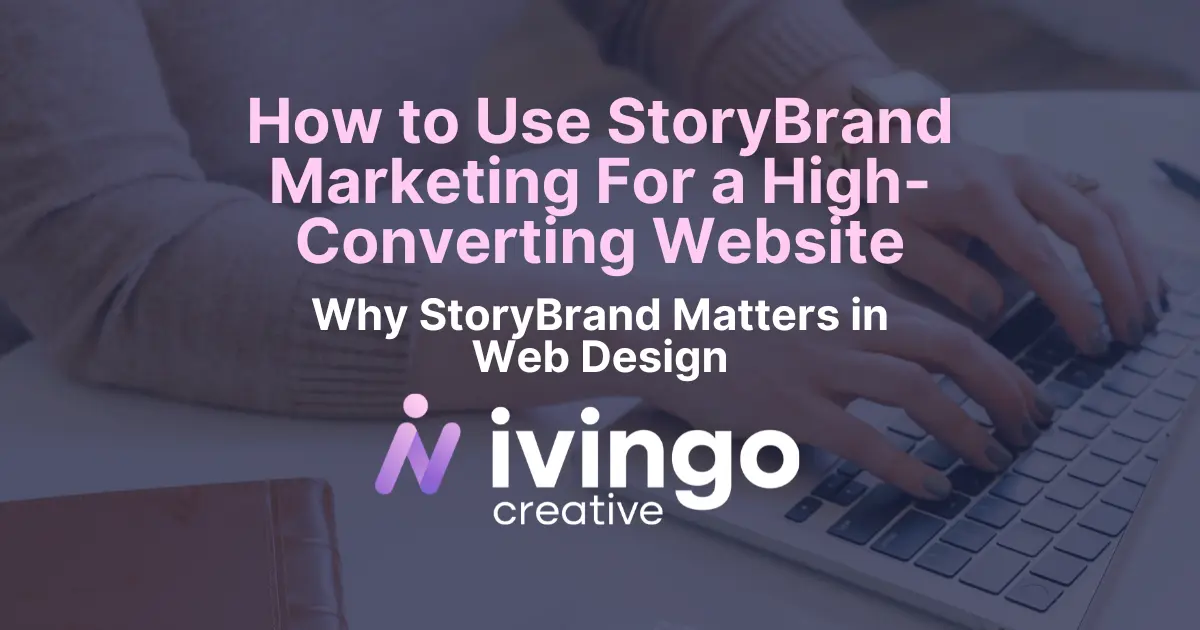Why StoryBrand Matters in Web Design
Most websites fail because they confuse visitors. Instead of guiding them toward a clear action, they overwhelm them with cluttered messaging and too many choices. The StoryBrand framework, created by Donald Miller, helps businesses simplify their messaging by positioning the customer as the hero and the business as the guide.
At Ivingo Creative, we use StoryBrand principles to design websites that are clear, engaging, and conversion-driven. In this guide, we’ll break down how to apply the StoryBrand framework to your website design—so your visitors instantly understand what you offer and take action.
What is the StoryBrand Framework?
The StoryBrand framework is built around the idea that your customer, not your brand, is the hero of the story. It follows a 7-part storytelling structure that makes messaging simple, clear, and compelling.
The 7 elements of StoryBrand are:
- A Character (Your Customer) – Your website should be about your ideal customer, not your business.
- Has a Problem – Call out their biggest pain points and struggles.
- Meets a Guide (You!) – Your brand should position itself as the expert guide, not the hero.
- Who Gives Them a Plan – A simple step-by-step process that helps them succeed.
- Calls Them to Action – A clear and singular CTA that moves them forward.
- That Helps Them Avoid Failure – Show what they’ll lose if they don’t take action.
- And Ends in Success – Help them envision how their life improves with your solution.
Now, let’s explore how to bring these principles into your website design.
How to Apply StoryBrand to Your Website Design
Make the Customer the Hero (Clear Messaging)
Your website is not about your company. It’s about your customer and their journey.
One of the biggest shifts businesses need to make in their marketing is understanding that your brand is not the hero—your customer is. Too many businesses make the mistake of centering their website messaging around themselves: “We’ve been in business for 20 years,” “We’re the best in the industry,” “We have award-winning services.” While credibility is important, customers aren’t visiting your website to learn about you—they’re looking for solutions to their own problems.
Your website should immediately make visitors feel like they are the focus. It should tell them, “This is for you. We understand what you need, and we’re here to help.” A strong website speaks directly to the visitor’s journey and how your business can guide them toward success.
For example, a web design agency could say, “Your business deserves a website that brings in leads, not one that just looks good. We help small businesses turn their websites into sales-generating machines.”
A financial planner might say, “Your future shouldn’t feel uncertain. We create clear, personalized financial plans so you can build wealth with confidence.”
A personal trainer could say, “You don’t need to spend hours in the gym to see results. Our customized workouts help busy professionals get fit without wasting time.”
When customers feel like they are the center of the story, they’re far more likely to trust your business. Instead of listing your achievements or talking about how great your company is, shift your website messaging to focus on how your service makes their life better. A small change in language can make a huge difference in how potential customers engage with your brand.
Small Action Step: If a visitor lands on your homepage, can they answer What do you do in five seconds or less? If not, your messaging needs work.
Define the Problem (Pain Points Front & Center)
People don’t buy products or services just because they exist—they buy solutions to problems. If your website doesn’t clearly address the challenges your customers are facing, they won’t feel compelled to take action. A strong website immediately speaks to the visitor’s pain points and reassures them that they’re in the right place.
Think about why customers seek your service in the first place. What frustrations or struggles are they dealing with? A web design client might be frustrated because their website isn’t generating leads. A small business owner might be overwhelmed with bookkeeping. A busy parent might struggle to find nutritious meal options for their kids. When you highlight these pain points in your messaging, potential customers feel seen and understood.
For example, instead of a generic statement like, “We offer professional cleaning services,” a home cleaning company could say, “Your home should be a place to relax, not another thing on your to-do list. We help busy families enjoy a clean home without the stress.”
A business coach might say, “Running a small business shouldn’t feel like guessing in the dark. We provide clear strategies to help you grow, without wasting time and money on what doesn’t work.”
A hair salon could say, “Tired of bad haircuts and stylists who don’t listen? We take the time to understand exactly what you want, so you leave feeling confident every time.”
By addressing the problem head-on, your website instantly resonates with visitors and keeps them engaged. When they see their own struggles reflected in your messaging, they’ll feel more confident that your business is the right solution.
Position Yourself as the Guide
One of the biggest mistakes businesses make in their messaging is positioning themselves as the hero. But in reality, your customer is the hero of the story—you are the guide who helps them succeed. Think of popular stories like Star Wars or Harry Potter. Luke Skywalker and Harry Potter are the heroes, but they both needed a wise guide—Yoda and Dumbledore—to show them the way. Your business plays the same role for your customers.
Instead of focusing on how great your business is, shift the focus to how you help customers overcome their challenges. A great way to do this is by showing both empathy and authority. Empathy shows that you understand the customer’s struggles, and authority reassures them that you have the expertise to solve their problem.
For example, if you run an accounting firm, instead of saying, “We have 20 years of experience in bookkeeping,” reframe it as: “We know that tax season is stressful, and keeping up with your books can feel overwhelming. That’s why we’ve helped hundreds of small business owners simplify their finances and stay tax-ready year-round.” This statement acknowledges the customer’s struggle while reinforcing your expertise.
A bakery might say, “We know how hard it is to find a cake that tastes as good as it looks. That’s why we create custom cakes that not only impress at your event but leave your guests raving about the flavor.”
A personal trainer might say, “Getting in shape can feel impossible when you’re trying to do it alone. That’s why we guide you with personalized workouts and coaching, so you can finally reach your fitness goals with confidence.”
No matter your industry, positioning yourself as the guide builds trust and helps customers see your business as the solution to their problems. Instead of making your website all about you, shift the focus to them—because when customers feel understood, they are far more likely to take action.
Offer a Simple Plan (Remove the Guesswork)
Visitors should never feel confused about how to take the next step with your business. If your website leaves them wondering, “What do I do now?” they will likely leave without taking action. Instead of overwhelming them with details, break down your process into three simple, easy-to-understand steps. This reassures potential customers that working with you is straightforward and achievable.
For example, instead of saying, “We offer custom web design services tailored to your needs,” give them a step-by-step breakdown of how they can get started. A clear plan might look like this:
- Schedule a Free Consultation
- Get a Custom Website Strategy
- Launch a Website That Converts
This approach removes hesitation by showing that there’s a clear, guided process from start to finish. When visitors know exactly what to expect, they feel more confident in moving forward. Keep your plan concise, avoid jargon, and focus on making the customer feel like success is just a few simple steps away.
Use a Single, Clear Call to Action (No “Go Here, Go There” Confusion)
Many businesses make the mistake of giving visitors too many choices on their homepage.
If your homepage says: “Schedule a Call!” “Read Our Blog!” “Check Out Our Portfolio!” “Follow Us on Social!”—you’re creating confusion instead of conversions.
Tip: Use ONE primary CTA, repeated multiple times, such as:
Schedule a Free Consultation” (Top-right button)
“Schedule a Free Consultation” (Mid-page section)
“Schedule a Free Consultation” (Bottom of the page)
Tip: Include a Transitional CTA for visitors who aren’t ready to commit yet.
Example: “Not ready to schedule a call? Download our free guide on increasing website conversions.”
Looking for more about Call to Actions? Read our deep dive on How to Use CTAs That Actually Convert
Show the Cost of Inaction (What’s at Stake?)
People are naturally hesitant to make decisions, especially when money, time, or effort is involved. One of the most powerful ways to drive action on your website is by making it clear what’s at stake if they don’t move forward. Customers need to see not just the benefits of working with you, but also the consequences of waiting or doing nothing.
When framing this, ask yourself:
- What problems will persist if the customer doesn’t take action?
- What frustrations will they continue to experience?
- What opportunities will they miss out on?
For example, a web design agency could highlight:
“An outdated, confusing website doesn’t just look bad—it’s costing you leads every single day. If your site isn’t converting visitors into customers, you’re leaving money on the table.”
A business coach might say:
“Without a clear growth strategy, you’ll keep spinning your wheels, feeling stuck, and wasting time on trial-and-error marketing that doesn’t work.”
A physical therapist could point out:
“Ignoring pain won’t make it go away. Without proper treatment, minor aches can turn into chronic issues that interfere with your daily life.”
By showing potential customers what they risk by staying in their current situation, you create urgency. They begin to realize that waiting isn’t neutral—it has a cost. When people feel the weight of inaction, they are much more likely to take that next step and move forward with your business.
Paint a Picture of Success (Social Proof & Testimonials)
People don’t just buy products or services—they buy a better version of their life. Your website should help visitors clearly envision what success looks like when they choose to work with you. What will improve? How will their problem be solved? What positive changes will they experience?
One of the best ways to do this is through clear, outcome-driven messaging, testimonials, and visuals that reinforce the transformation your business provides. Instead of just listing features, show how your product or service impacts their life for the better.
For example, a web design agency could say:
“Imagine having a website that actually brings in leads—one that works 24/7 to grow your business while you focus on what you do best. Our clients see an average increase of 200% in conversions after working with us.”
A nutrition coach might say:
“No more restrictive diets or frustration over what to eat. With our personalized meal plans, you’ll finally have a sustainable approach to healthy eating that gives you more energy, better digestion, and a happier relationship with food.”
A real estate agent could emphasize:
“Picture yourself in your dream home—no more endless house hunting, just a smooth, stress-free buying experience that gets you the perfect home at the right price.”
By painting a vivid picture of success, you help visitors emotionally connect to the outcome you offer. Pair this messaging with real customer testimonials, before-and-after transformations, or case studies to reinforce the credibility of your claims. The clearer you can make the end result, the easier it is for potential customers to see themselves achieving it—and taking action to get there.
StoryBrand Website Checklist
✅ Clear, customer-focused headline
✅ Identifies the customer’s pain points
✅ Establishes the business as the guide
✅ Offers a simple, step-by-step plan
✅ Strong, repeated calls to action
✅ Shows the cost of inaction
✅ Paints a picture of success
Why StoryBrand Websites Convert Better
A website built with the StoryBrand framework is clear, engaging, and conversion-focused. It eliminates confusion, speaks directly to your customer’s needs, and drives action.
At Ivingo Creative, we specialize in designing StoryBrand-inspired websites that turn visitors into customers. If your website isn’t converting, let’s chat!
Need a high-converting website? Schedule a Free Consultation



